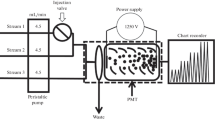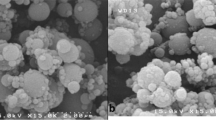Abstract
A luminol chemiluminescence (CL) detection/flow injection analysis technique coupled with ion chromatography (IC) has been employed for the determination of low levels of Cu(II) and Co(II) in drinking water samples. The detection system was the CL of luminol/perborate or luminol/percarbonate in alkaline medium catalyzed by these transition metals. Oxalic acid in a solution of KOH and N(CH3)4OH was used as an eluent in the IC to improve the column selectivity (Dionex CS5A). Concentration and pH of the eluent affected simultaneously the CL intensity and the retention times (t R). Under the elution conditions used here, the retention times of both metal ions were much greater when the concentration of oxalic acid was decreased. Thus, R t(Cu) = 2.15 min and t R(Co) = 4.50 min were measured at 80 mM oxalic acid concentration, while t R raised to 4.12 and 18 min for Cu(II) and Co(II), respectively, using a 10-mM concentration, but on the other hand, the CL signals showed substantially higher values when the concentration of oxalic acid was lesser in the eluent. An optimum oxalic acid concentration of 20 mM and an eluent pH = 4.7 were selected in order to have reproducible signals with a total analysis time of 10 min. The optimum flow rate for the mobile phase was 1.5 mL min−1. The concentration and pH of the postcolumn reagents also affected the CL signal, obtaining optimum concentrations of 5 mM for both oxidants (perborate or percarbonate) and luminol, this last dissolved in a 0.1-M borate buffer at pH 12. The optimum flow rate for the postcolumn reagents was 1 mL min−1. Linear calibrations for both transition metal ions were established, with calculated detection limits of 0.15 ng mL−1 for Co(II) and 0.20 μg mL−1 for Cu(II). Others ions commonly present in natural waters showed little or no interference. The method was successfully applied to water samples spiked with Cu(II) and Co(II), obtaining recoveries in the range of 85–128%, depending on the metal concentrations.



Similar content being viewed by others
References
Ahmed MJ, Uddin MN (2007) A simple spectrophotometric method for the determination of cobalt in industrial, environmental, biological and soil samples using bis(salicylaldehyde)orthophenylenediamine. Chemosphere 67(10):2020–2027
Badocco D, Pastore P, Favaro G, Macca C (2007) Effect of eluent composition and pH and chemiluminescent reagent pH on ion chromatographic selectivity and luminol-based chemiluminescent detection of Co2+, Mn2+ and Fe2+ at trace levels. Talanta 72:249–255
Burguera JL, Burguera M, Towsend A (1981) Determination of zinc and cadmium by flow injection analysis and chemiluminescence. Anal Chim Acta 127:199–201
Chen YC, Jian YL, Chiu KH, Yak HK (2012) Simultaneous speciation of Iron (II) and Iron(III) by ion chromatography with chemiluminescence detection. Anal Sci 28:795–799
Corley J (2002) Best practices in establishing detection and quantification limits for pesticide residues in foods. In: Lee P (ed) Handbook of residue analytical methods for agrochemicals. Wiley, West Sussex
Correa E, Vitorino A (2002) Chemiluminescence as an analytical tool: from the mechanism to applications of the reaction of luminol in kinetic based methods. Quimica Nova 25(6):1003–1011
Dulaquais G, Boye M, Middag R, Owens S, Puigcorbe V, BuesselerK Masques P, de Baar H, Carton X (2014) Contrasting biogeochemical cycles of cobalt in the surface western Atlantic Ocean. Global Biogeochem Cycles 28(12):1387–1412
Gammelgaard B, Liao Y, Jons O (1997) Improvement on simultaneous determination of chromium species in aqueous solution by ion chromatography and chemiluminescence detection. Anal Chim Acta 354(1):107–113
Gao W, Qi W, Jianping L, Qi L, Saadat M, Guobao X (2015) Thiourea dioxide as a unique eco-friendly coreactant for luminol chemiluminescence in the sensitive detection of luminol, thiourea dioxide and cobalt ions. Chem Commun 51:1620–1623
Issam M, Shakir A, Zaineb F, Hassan A (2015) Chemiluminometric-CFIA for the determination of Cobalt(ll) ion in commercial cobalt–molybdenum catalyst (K F124-3E) used in desulphurization processes of petroleum products via multi gel beads reactor. Iraqi J Sci 56(1):38–52
Khorrami AR, Hashempur T, Mahmoudi A, Karimi AR (2006) Determination of ultra trace amounts of cobalt and nickel in water samples by inductively coupled plasma-optical emission spectrometry after preconcentration on modified C18-silica extraction disks. Microchem J 84:75–79
Kim KM, Kim YH, Oh S, Lee SH (2013) A chelate complex-enhanced luminol system for selective determination of Co(II), Fe(II) and Cr(III). Luminescence 28:372–377
Lemos V, Santos JS, Baliza PX (2006) Me-BTABr reagent in cloud point extraction for spectrometric determination of copper in water samples. J Braz Chem Soc 17(1):30–35
Li B, Wang D, Lv J, Zhang Z (2006) Flow-injection chemiluminescence simultaneous determination of Cobalt(II) and Copper(II) using partial least squares calibration. Talanta 69:160–165
Lu C, Lin C, Huie W, Yamada M (2003) Simultaneous determination of Copper(II) and Cobalt(II) by ion chromatography coupled with chemiluminescent detection. Anal Sci 19:551–557
Murillo JA, García L, Carrasquero A (2013) Fast simultaneous determination of traces of Cu(II) and Co(II) in soils and sediments with the luminol/perborate chemiluminescent system. Environ Monit Assess 158(1):573–577
Neal C, Jarvie HP, Whitton BA, Gemmell J (2000) A simple spectrophotometric method for the determination of cobalt in industrial, environmental, biological and soil samples using bis(salicylaldehyde)orthophenylenediamine. Sci Total Environ 251(252):153–172
Roda A, Guardigli M (2012) Analytical chemiluminescence and bioluminescence: latest achievements and new horizons. Anal Bioanal Chem 402:69–76
Xiao CB, King DW, Palmer DA, Wesolowski DJ (2000) Study of enhancement effects in the chemiluminescence method for Cr(III) in the ng l−1 range. Anal Chim Acta 415(1–2):209–219
Yamane T, Watanabe K, Mottola A (1998) Continuous-flow system for the determination of cobalt in sea and river water: in-line preconcentration/separation coupled with catalytic determination. Anal Chim Acta 207:331–336
Author information
Authors and Affiliations
Corresponding author
Additional information
Editorial responsibility: M. Abbaspour.
Rights and permissions
About this article
Cite this article
Murillo Pulgarín, J.A., García Bermejo, L.F. & Carrasquero Durán, A. An easy and fast IC-CL procedure for the monitoring of Cu(II) and Co(II) in environmental samples. Int. J. Environ. Sci. Technol. 14, 233–240 (2017). https://doi.org/10.1007/s13762-016-1154-5
Received:
Revised:
Accepted:
Published:
Issue Date:
DOI: https://doi.org/10.1007/s13762-016-1154-5




